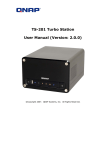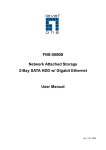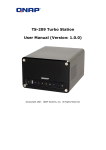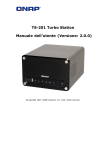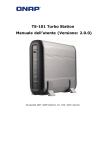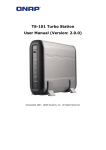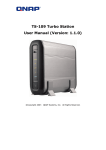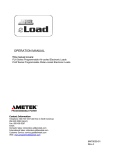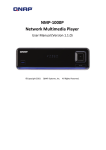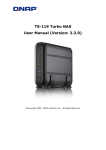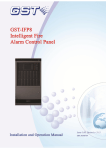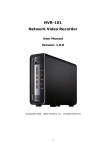Download QNAP Turbo Station TS-201 User manual
Transcript
TS-201 Turbo Station User Manual (Version: 1.0.0) ©Copyright 2006. QNAP Systems, Inc. All Rights Reserved. FOREWORD Thank you for choosing QNAP products! instructions of using TS-201. This user manual provides detailed Please read carefully and start to enjoy the powerful functions of TS-201! NOTE • All features, functionality and other product specifications are subject to change without prior notice or obligation. • All brands and products names referred to are trademarks of their respective holders. LIMITED WARRANTY In no event shall the liability of QNAP Systems, Inc. (QNAP) exceed the price paid for the product from direct, indirect, special, incidental, or consequential software, or its documentation. QNAP makes no warranty or representation, expressed, implied, or statutory, with respect to its products or the contents or use of this documentation and all accompanying software, and specifically disclaims its quality, performance, merchantability, or fitness for any particular purpose. QNAP reserves the right to revise or update its products, software, or documentation without obligation to notify any individual or entity. CAUTION 1. 2. Back up your system periodically to avoid any potential data loss. QNAP disclaims any responsibility of all sorts of data loss or recovery. Should you return any components of TS-201 Turbo Station package for refund or maintenance, make sure they are carefully packed for shipping. Any form of damages due to improper packaging will not be compensated. -2- Safety Warnings 1. TS-201 can operate normally in the temperature of 0℃-35℃ and relative humidity of 0%-85%. Please make sure the environment is well-ventilated. 2. The power cord and devices connected to TS-201 must provide correct supply voltage (60W, 90-264V). 3. Do not place TS-201 in direct sunlight or near chemicals. Make sure the temperature and humidity of the environment are in optimized level. 4. Unplug the power cord and all connected cables before cleaning. Wipe TS201 with a wet towel. Do not use chemical or aerosol to clean TS-201. 5. Do not place any objects on TS-201 for the server’s normal operation and to avoid overheat. 6. Use the flat head screws in the product package to lock the hard disks in TS201 when installing hard disks for proper operation. 7. Do not place TS-201 near any liquid. 8. Do not place TS-201 on any uneven surface to avoid falling off and damage. 9. Make sure the voltage is correct in your location when using TS-201. If you are not sure, please contact the distributor or the local power supply company. 10. Do not place any object on the power cord. 11. Do not attempt to repair your TS-201 in any occasions. Improper disassembly of the product may expose you to electric shock or other risks. For any enquiries, please contact the distributor. -3- Table of Contents Table of Contents .....................................................................................4 Chapter 1. Overview of TS-201 Turbo Station .....................................7 1.1 Introduction...................................................................................7 1.2 Package Contents ...........................................................................8 1.3 Hardware Illustration ......................................................................9 Chapter 2. Install TS-201 ..................................................................10 2.1 Install Hard Disk........................................................................... 10 2.2 Hard Disk Recommendation List...................................................... 12 2.3 Set up TS-201.............................................................................. 14 2.4 Check System Status .................................................................... 16 2.5 Configure Software Settings ........................................................... 18 2.5.1 Windows® Users ...................................................................... 18 2.5.2 Mac Users............................................................................... 34 Chapter 3. Enjoy the Powerful Services of TS-201 ............................43 3.1 Server Administration.................................................................... 48 3.2 Quick Configuration 3.3 System Settings ....................................................... 49 ............................................................ 53 3.3.1 Server Name........................................................................... 53 3.3.2 Date & Time ........................................................................... 54 3.3.3 Encoding Setting ..................................................................... 55 3.3.4 View System Settings............................................................... 55 3.4 Network Settings .......................................................... 56 3.4.1 TCP/ IP Configuration ............................................................... 56 3.4.2 Microsoft Networking................................................................ 58 3.4.3 Apple Network......................................................................... 60 3.4.4 Web File Manager .................................................................... 60 3.4.5 FTP Service............................................................................. 61 3.4.6 Multimedia Station................................................................... 62 3.4.6.1 3.4.7 UPnP Media Server ............................................................. 62 Download Station .................................................................... 63 -4- 3.4.8 Web Server ............................................................................ 64 3.4.9 View Network Settings ............................................................. 65 3.5 Device Configuration ...................................................... 66 3.5.1 SATA Disk .............................................................................. 67 3.5.2 USB Disk ................................................................................ 69 3.5.3 USB Printer............................................................................. 70 3.6 User Management ......................................................... 72 3.6.1 Users ..................................................................................... 72 3.6.2 User Groups............................................................................ 74 3.6.3 Quota .................................................................................... 81 3.7 Network Share Management ........................................... 83 3.7.1 Create ................................................................................... 84 3.7.2 Property ................................................................................. 85 3.7.3 Access Control ........................................................................ 86 3.7.4 Delete.................................................................................... 86 3.7.5 Restore .................................................................................. 87 3.8 System Tools ................................................................ 88 3.8.1 Alert Notification...................................................................... 89 3.8.2 Restart/ Shutdown................................................................... 89 3.8.3 Hardware Settings ................................................................... 90 3.8.4 System Update........................................................................ 91 3.8.5 Change Logo........................................................................... 92 3.8.6 Remote Replication (Disaster Recovery)...................................... 93 3.8.7 Backup/ Restore/ Reset Settings................................................ 96 3.9 Event Logs ................................................................... 97 Chapter 4. Copy Data Directly by Front USB Port to TS-201 ..............98 Chapter 5. Multimedia Station ...........................................................99 Chapter 6. Download Station........................................................... 106 Chapter 7. Web Server .................................................................... 114 Chapter 8. FTP Server ..................................................................... 118 Chapter 9. Web File Manager .......................................................... 121 -5- Chapter 10. NetBak Replicator ................................................... 126 Chapter 11. TS-201 Maintenance ...................................................... 141 11.1 Restart/ Shut down Server........................................................... 141 11.2 Reset Administrator Password and Network Settings ........................ 142 11.3 Disk Failure or Malfunction ........................................................... 143 11.4 Power Outage or Abnormal Shutdown............................................ 143 Technical Support ................................................................................ 144 -6- Chapter 1. Overview of TS-201 Turbo Station 1.1 Introduction Thank you for choosing TS-201 Turbo Station. This product has the following key features: 9 9-in-1 server: Multimedia Station, Download Station, Mirror Station, Disaster Recovery, Web Server, Backup Server, File Server, FTP Server, and Printer Server. 9 Easy-to-use, simple configuration in a few steps and TS-201 is ready to use! 9 Supports RAID 0, RAID 1 and JBOD disk volume 9 Supports PHP and SQLite to establish interactive websites 9 Supports UPnP multimedia technology for sharing of multimedia files at home 9 Supports 2 large-sized SATA disks and hotswap function 9 3 high speed USB 2.0 (480Mbps) ports to support multiple USB devices like printer, disk, digital camera, thumb drive, card reader etc. to provide diversified functions. 9 High speed transfer, 480MB USB 2.0, Gigabit Ethernet, 1.5GB SATA high speed file transfer. With highly efficient block level algorithm, data transfer can be done instantly. 9 Incomparable high reliability, most complete and reliable data backup: instant/ schedule/ real-time backup and can compress data to remote location. -7- 1.2 Package Contents Your TS-201 package contains: 9 TS-201 Turbo Station 9 Adaptor 9 Power cord 9 CD-ROM (user manual, Quick Install Wizard & utility inclusive) 9 Quick Installation Guide 9 Flat head screws x 8 9 Ethernet cable x 1 9 Front panel x 1 9 Thumb screws x 4 -8- 1.3 Hardware Illustration One Touch Copy Button Power Button USB 2.0 LED Indicators: USB, Status, HDD1, HDD2, LAN, and Power K-Lock Security Slot Power Connector Reset Button Giga LAN -9- USB 2.0 x 2 Chapter 2. Install TS-201 2.1 Install Hard Disk 1. Loosen the screws on the disk trays and take out the disk trays. 2. Install a hard disk on each tray. Make sure the disk holes match the holes at the base of the disk tray and lock the disk with four screws. - 10 - 3. Insert the disk trays to TS-201. Push the disk trays to the end. Fasten the screws on the trays. When two disks are installed, make sure HDD1 is installed on top of HDD2. 4. Remove the protection films on the LED panel and both sides of the front panel. 5. Cover TS-201 with the front panel and fasten the four screws. - 11 - 2.2 Hard Disk Recommendation List The following HDD models are verified by QNAP that are compatible with TS-201. It is recommended to use the disk models listed here. Other HDD brands that are not tested by QNAP may or may not work properly with TS-201. For more updated compatible hard disk information, please visit QNAP website at www.qnap.com.tw. QNAP disclaims any responsibility for product damage/ malfunction or data loss/ recovery due to misuse or improper installation of hard disks in any occasions for any reasons. Seagate Model Name Capacity Rotational (GB) Speed (RPM) Buffer Size (MB) Model No. Interface Barracuda 7200.9 SATA ST3500641AS SATA II 3Gb/s with NCQ 500 7200 16 Barracuda 7200.10 SATA ST3320620AS SATA II 3Gb/s with NCQ 320 7200 16 Barracuda 7200.9 SATA ST3300622AS SATA II 3Gb/s with NCQ 300 7200 16 Barracuda 7200.8 SATA ST3250823AS SATA 1.5Gb/s with NCQ 250 7200 8 Barracuda 7200.7 SATA ST3160827AS SATA 1.5Gb/s with NCQ 160 7200 8 Barracuda 7200.7 SATA ST3120827AS SATA 1.5Gb/s with NCQ 120 7200 8 Maxtor Model Name Model No. Interface DiamondMax 10 6B200M0 SATA 1.5Gb/s with NCQ Capacity Rotational (GB) Speed (RPM) 200 7200 Buffer Size (MB) 8 Hitachi Model Name Model No. Deskstar 7K400 HDS724040KLSA80 Interface SATA 1.5Gb/s - 12 - Capacity Rotational (GB) Speed (RPM) 400 7200 Buffer Size (MB) 8 Western Digital Model Name Model No. WD Caviar® SE Serial ATA WD4000KD WD Caviar SE16 Interface Capacity Rotational (GB) Speed (RPM) Buffer Size (MB) SATA 1.5Gb/s 400 7200 16 WD3200KS SATA II 3Gb/s 320 7200 16 - 13 - 2.3 Set up TS-201 Please check your network environment and select the appropriate installation method before installing TS-201. 1. Office/ Home Connect TS-201 and PC to the same hub/ switch/ router. 2. Individual Connect TS-201 directly to your PC by a network cable. - 14 - When you have verified your network environment, please follow the steps below to install TS-201. 1 Network cable USB cable 2 3 1. Connect TS-201 to hub/ switch/ router or PC according your network environment. 2. Connect USB printer to TS-201 and enable USB printer service*. 3. Connect the power. 4. Press the power button of TS-201 to turn on the server. * Optional step. You can skip this step if you are not using printer service. - 15 - 2.4 Check System Status TS-201 provides LED indicators for you to indicate system status and information easily. When TS-201 is turned on, please check the following items to make sure system status is normal. Note that the following LED information is applicable only when you have properly installed HDD1 and/or HDD2, and connected TS-201 to the network and power. n Power o LAN p HDD2 q HDD1 r Status s USB Status LED System starting up System has started nPower oNetwork (LAN) q/pHDD1/ HDD2 Blue Blue Blink in orange Orange Orange ÆBlink in orange Off Blink in red (short beep once) Æ Blink in green (long beep once) Green rStatus - 16 - LED Display & System Status Overview LED nPower oLAN q/pHDD1/ HDD2 LED Display & System Status Blue: System has started Blink in orange: Accessing network Blink in orange: Accessing data Green: System is normal Blink in green: Hard disk not detected Blink in red: Bad blocks are found in hard disk rStatus Blink in green for 5 seconds, blink in green and red alternatively: Hard disk not initialized Blink in green and red alternatively: Disk capacity is almost full (long beep twice) Blink in red: Disk full sFront USB Status Blue: You can press the copy button to copy data. Blink in blue: Copying data Blink in blue once: Detecting or removing USB device Other Status Action Update firmware System shut down HDD standby mode RAID 1 degraded mode RAID 1 rebuilding LED In Process Finished nPower Blink in blue Blue rStatus Blink in green and red alternatively Green (long beep thrice) nPower rStatus nPower rStatus nPower rStatus nPower rStatus Blink in blue Off Off (short beep once) Off Blue Off Blue Red (long beep twice) N/A N/A Blue Blue Blink in red (long beep twice) Green - 17 - 2.5 Configure Software Settings After checking system status, please follow the steps below to configure software settings of TS-201. The configuration procedure of Windows and Mac users are different. Please select the appropriate procedure according to your OS. 2.5.1 Windows® Users Insert TS-201 CD-ROM in your PC. Wait for a few seconds until the following screen shows up. Then start to configure the software settings of TS-201. 1. Select TS-201. - 18 - 2. Install Quick Install Wizard. - 19 - 3. Run Quick Install Wizard. When the wizard prompts for performing quick configuration, click OK. Enter the default user name and password. Default user name: administrator Password: admin - 20 - When you have entered quick configuration page, follow the instructions to complete the settings. Click Next to continue. - 21 - Step 1. Enter the server name and click Next. - 22 - Step 2. Enter a new password or select to use the original password. Click Next to continue. - 23 - Step 3. Select the time zone of your location or enter the date and time manually. You can also select to synchronize the time of TS-201 with an Internet time server automatically. Click Next to continue. - 24 - Step 4. Select the encoding language of TS-201 and click Next. Note: All files and directories on TS-201 will be created using Unicode encoding. If your FTP client or PC does not support Unicode, e.g. Windows® 95, 98, ME OS, select the language the same as the OS of your PC here in order to view the files and directories on the server properly. - 25 - Step 5. It is recommended to use DHCP protocol to acquire IP address automatically. If your network does not support DHCP, please enter the IP address settings and click Next. Note: If you select to enter IP address manually, please make sure your PC and TS-201 are in the same LAN. If you are not sure about the network settings, please contact your network administrator or ISP. - 26 - Step 6. When one or two hard drives are installed in TS-201, select the RAID configuration and click Next to format. Note: All data on the drives will be deleted unless you select “Same configuration as the current one”. - 27 - Step 7. You have finished quick configuration. Please make sure all settings are correct and click Next to start disk formatting. - 28 - Step 8. Please wait patiently when formatting the disk(s). Formatting may take a few minutes depending on the capacity of your hard drives. When finished, click Next to proceed. - 29 - Congratulations! You have finished Quick Configuration. Your TS-201 is ready to use. TS-201 provides several default share folders for data sharing and access. To map the share folders on TS-201 as your drive, check the option “Continue to map network drive for me” and follow the steps below to proceed. To start to use TS-201 immediately, you can skip to 4. - 30 - a. For example, to map the folder Public as your drive, select the folder and click Map Network Drive. Note: The share folders Qdownload, Qmultimedia, Qusb, and Qweb are system default network share of TS-201 for the use of Download Station, Multimedia Station, USB auto-copy and Web Server. b. Select the drive letter for the connection and click Finish. - 31 - c. Upon successful connection, you can start to use the share folder on TS201. You can access these folders by opening My Computer. 4. Quick Install Wizard will appear when all configurations are completed. Click on the name of TS-201 on the list to enter administration page. - 32 - 5. When the administration page of TS-201 is shown, you can start to use the services. If you have any questions during web administration, please click the help button on the top right hand corner of the page. To modify system settings, click Administration. Enter the user name and password to login. Default user name: administrator Password: admin Note: It is recommended to use Internet Explorer 6.0 or above to access TS-201. If the OS of your PC is Windows® 98, TS-201 supports Internet Explorer 6.0 or above only. - 33 - 2.5.2 Mac Users TS-201 provides two methods for Mac users to connect to TS-201. You can select A. Connect TS-201 by Mac directly or B. Connect TS-201 by the network. A. Connect TS-201 by Mac directly 1. Please go to Network settings and select Using DHCP. Then connect TS201 to your Mac via a cable. 2. Open a web browser and enter the default IP address of TS-201 to login the system. Default IP of TS-201: http://169.254.100.100:6000 Note: Please use the browser Safari in Mac to access TS-201. - 34 - 3. When the administration page is shown, click Administration. Enter the default user name and password to login. Default user name: administrator Password: admin - 35 - 4. Follow the step-by-step guide in Quick Configuration to complete the settings of TS-201. If you have any questions during web administration, please click the help button on the top right hand corner of the page. - 36 - B. Connect TS-201 by the network 1. Please go to Network settings to check and write down the subnet and router address of your Mac. Then select Using DHCP. Note: If you are not sure about the network settings, please contact your network administrator or ISP. 2. Connect TS-201 to your Mac by a cable. Open a web browser and enter the default IP address of TS-201. Default IP address of TS-201: http://169.254.100.100:6000 Note: Please use the browser Safari in Mac to access TS-201. - 37 - 3. When the administration page is shown, click Administration. Enter the default user name and password to login. Default user name: administrator Password: admin - 38 - 4. Go to TCP/IP Configuration of Network Settings . Select to use static IP and input the IP address of TS-201. Make sure the value does not conflict with the IP address of your Mac and other devices in LAN. Configure the subnet mask and default gateway of TS-201 to the same as subnet mask and router address of Mac which you set in Step 1. Click Apply to confirm. Note: When using static IP, please make sure your Mac and TS-201 are in the same subnet. If you are not sure about the settings, please contact your network administrator or ISP. - 39 - 5. Click Yes to restart TS-201 for the changes to take effect. Please wait patiently for TS-201 to restart. 6. Connect your Mac and TS-201 to the network. Open a web browser and enter the IP address of TS-201 you set up in step 4. Note: Please use the browser Safari in Mac to access TS-201. - 40 - 7. Click Administration and enter the default user name and password to login. Default user name: administrator Password: admin - 41 - 8. Follow the step-by-step guide in Quick Configuration to complete the settings of TS-201. If you have any questions during web administration, please click the help button on the top right hand corner of the page. - 42 - Chapter 3. Enjoy the Powerful Services of TS-201 TS-201 provides the following powerful functions and applications. A. Use network share-Public folder 1. You can access the public folder of TS-201 by the following means: a. Open My Network Places and find the workgroup of TS-201. If you cannot find the server, please browse the whole network to search for TS-201. Double click the name of TS-201 for connection. b. Use Run function in Windows®. Enter \\[TS-201 name]* or \\[TS-201 IP]# to access share folder on TS-201. c. Windows® users can use Quick Install Wizard to find TS-201. When the administration page is shown, click Web File Manager. Enter the user name and password, and then start to manage TS-201. 2. You can upload files to the Public folder. - 43 - B. Manage TS-201 Manage TS-201 using web browser by Windows® or Mac 1. You can access TS-201 web administration page by the following methods: a. Windows® users can use Quick Install Wizard to find TS-201. b. Windows® and Mac users can open a web browser and enter http://[TS-201 IP]:6000# Note: 1. It is recommended to use Microsoft® Internet Explorer 6.0 or above to access TS-201. If the OS of your PC is Windows® 98, TS-201 supports Internet Explorer 6.0 only. 2. Please use the browser Safari in Mac to access TS-201. *The user name here should be the same as the server name you enter in Chapter 2.5 Configure Software Settings. #The IP address here should be the same as the IP address you enter in Chapter 2.5 Configure Software Settings. If you are using DHCP: (a) connect the PC to TS-201 directly, please use the default IP address 169.254.100.100:6000 of TS-201; (b) connect TS-201 by network, please run Quick Install Wizard to view the IP address of TS-201. - 44 - 2. When the administration page is shown, click Administration, Web File Manager, Web Server, Multimedia Station, or Download Station. Enter the user name and password, and then start to manage TS-201. For further details, please refer to the user manual in TS-201 CD-ROM. - 45 - C. Use TS-201 Services Multimedia Station TS-201 provides a user-friendly web management interface for you to manage and share personal albums and multimedia files via network easily. Supports UPnP multimedia technology to set up multimedia sharing center at home. Please refer to Chapter 5. Download Station TS-201 supports P2P download mechanism. You can add download task to TS-201 and let the server finish downloading independently of your PC. Please refer to Chapter 6. Mirror Station Provides RAID 1 mirroring disk volume for data protection. Please refer to Chapter 3.5.1. Disaster Recovery TS-201 supports remote share folder backup via the network. In case of data damage in PC, you can restore all backup data. Please refer to Chapter 3.8.6. Web Server TS-201 enables you to create your own website easily. It also supports PHP and SQLite to establish interactive websites. Please refer to Chapter 7. Printer Server TS-201 supports network printer sharing function by direct USB connection. No extra help from PC is needed. Please refer to Chapter 3.5.3. FTP Server TS-201 offers the simplest FTP server setup procedure for you to establish FTP server without any professional assistance. Please refer to Chapter 8. - 46 - Backup Server NetBak Replicator is a powerful backup software designed for Windows users to configure automatic backup schedule. Block level remote replication is supported to provide the most reliable, instant and secure data backup mechanism. Please refer to Chapter 10. File Server TS-201 provides convenient and secure file server functions that support central data management. Users can be granted with the right to access network share and share important files. Please refer to Chapter 3.7 and Chapter 9. - 47 - 3.1 Server Administration There are 8 main sections in server administration: - 48 - 3.2 Quick Configuration Please follow the step-by-step guide in Quick Configuration to complete the settings of TS-201. If you have any questions during web administration, please click the help button on the top right hand corner of the page. Other buttons are described as below: : Return to previous page : Return to home page : Logout system Step 1. Enter the server name. - 49 - Step 2. Change the administrator password or select to use the original password. Step 3. Enter the date, time and select the time zone for the server. Step 4. Select the language the server uses to display files and directories. The default setting is English. - 50 - Step 5. Enter the IP address, subnet mask and default gateway for the server. Step 6. Initialize disk volume in TS-201 for the first time configuration. - 51 - Step 7. When TS-201 is initialized, the basic settings will be shown. - 52 - 3.3 System Settings Basic system settings include the server name, date, time, and view system settings. 3.3.1 Server Name Enter the name of TS-201. The server name can be 14 characters long at maximum, which supports alphabets, numbers and hyphen (-). The server does not accept names with space, period (.), or names in pure number. - 53 - 3.3.2 Date & Time Set the date, time, and time zone according to your location. If the settings are incorrect, the following problems may occur: 9 When using a web browser to access or save a file, the display time of the action will be incorrect. 9 The time of event log displayed will be inconsistent with the actual time when an action occurs. 9 Synchronize with an Internet time server automatically You can enable this option to update the date and time of the system automatically with specified NTP (Network Time Protocol) server. Enter the IP address or domain name of the NTP server, e.g. time.nist.gov, time.windows.com. Then enter the time interval for adjusting the time (minimum value is 1 minute and maximum value is 99 days). Note: The first time you enable NTP server, it may take several minutes for time synchronization before the time is correctly adjusted. - 54 - 3.3.3 Encoding Setting Select the language TS-201 uses to display files and directories. Note: All files and directories on TS-201 will be created using Unicode encoding. If your FTP clients or the OS of your PC does not support Unicode, e.g. Windows® 95/98/ME, select the language the same as your OS here in order to view the files and directories on the server properly. 3.3.4 View System Settings You can view all current system settings, e.g. server name, on this page. - 55 - 3.4 Network Settings You can configure network settings in this section and enable several powerful applications of TS-201, e.g. Multimedia Station, Download Station, and Web Server. 3.4.1 TCP/ IP Configuration You can select one of the following two methods to configure the TCP/IP settings of TS-201. 1. Obtain IP address settings automatically via DHCP If your network supports DHCP, TS-201 will use DHCP protocol to retrieve the IP address and related information automatically. 2. Use static IP address To use fixed IP address for network connection, enter fixed IP address, subnet mask and default gateway. Primary DNS Server: Enter the IP address of primary DNS server that provides DNS service for TS-201 in external network. Secondary DNS Server: Enter the IP address of secondary DNS server that provides DNS service for TS-201 in external network. - 56 - Jumbo Frame Settings (MTU) "Jumbo Frames" refer to Ethernet frames that are larger than 1500 bytes. It is designed to enhance Ethernet networking throughput and reduce the CPU utilization of large file transfers by enabling more efficient larger payloads per packet. Maximum Transmission Unit (MTU) refers to the size (in bytes) of the largest packet that a given layer of a communications protocol can transmit. TS-201 uses standard Ethernet frames: 1500 bytes by default. If your network appliances support Jumbo Frame setting, select the appropriate MTU value for your network environment. TS-201 supports 4074 and 9000 bytes for MTU. Note: Jumbo Frame setting is valid in Gigabit network environment only. Besides, all network appliances connected must enable Jumbo Frame and use the same MTU value. - 57 - 3.4.2 Microsoft Networking Enable file service for Microsoft networking: If you are using Microsoft® Windows®, enable this service to access the files on network share folders. Assign a workgroup name. 9 Standalone Server Use local users for user authentication. 9 WINS server If the local network has a WINS server installed, specify the IP address. TS201 will automatically register its name and IP address with WINS service. If you do not want to enable WINS server support, or you do not have a WINS server on your network, enter 0.0.0.0 in the field for WINS server IP address. - 58 - 9 Domain Master There is a unique Domain Master Browser for collecting and recording resources and services available for each PC in the network or workgroup of Windows. When a domain master browser (Windows® NT/ 200x/ XP PC) exists already in the network, there is no need to configure TS-201 as the domain master. When you find the waiting time for accessing Network Neighborhood too long, it may be caused by failure of an existing master browser, or there is no master browser in the network. If there is no master browser in your network, you can check the box Domain Master in this section to configure TS-201 as the master browser to enhance the speed of accessing information on Network Neighborhood. - 59 - 3.4.3 Apple Network To use TS-201 on Apple Mac operating system, enable AppleTalk network support. If your AppleTalk network uses extended networks, and is assigned with multiple zones, assign a zone name to TS-201. If you do not want to assign a network zone, enter an asterisk (*) to use the default setting. This setting is disabled by default. 3.4.4 Web File Manager To access files on TS-201 via web browser, enable Web File Manager. If TS-201 is connected to the Internet and uses a valid IP address, you can access files on the server by web browser from anywhere. For more information, please refer to Chapter 9. - 60 - 3.4.5 FTP Service When you enable FTP service, you can define the port number for the service and maximum number of users connected to the FTP at the same time. Select to enable or disable Unicode Support. The default setting is No. Since most FTP clients do not support Unicode currently, it is recommended that you disable Unicode support here and select the language the same as your OS in “System Settings—Encoding Setting” page so that the folders and files on FTP can be properly shown (please refer to Chapter 3.3.3). If your FTP client supports Unicode, make sure you have enabled Unicode support for both your client and TS-201. - 61 - 3.4.6 Multimedia Station To share multimedia files like photos, music or video files on the network, please enable Multimedia Station. For further information, please refer to Chapter 5. 3.4.6.1 UPnP Media Server TS-201 supports UPnP technology which brings you greater convenience to enjoy multimedia files. By enabling UPnP Media Server, you can share pictures, music and video files on a specific share folder of TS-201 (default is Qmultimedia) with any multimedia player that supports UPnP in home and corporate networks. The multimedia player can then search for all supported multimedia files available in the share folder of TS-201 and play the files on a display device, e.g. TV. To use UPnP Media Server, please enable this function and click the following link (http://TS-201 IP:9000/) to enter the configuration page of UPnP Media Server. For the use of UPnP Media Server, please visit QNAP website at www.qnap.com.tw. About UPnP Universal Plug and Play (UPnP) is a set of computer network protocols promulgated by the UPnP Forum. The purpose of UPnP is to allow devices to connect seamlessly and to simplify the implementation of networks at home and in corporate environment. UPnP achieves this by defining and publishing UPnP device control protocols built upon open, Internet-based communication standards. The term UPnP is gleaned from Plug-and-play, a technology for dynamically attaching devices to a computer directly. - 62 - 3.4.7 Download Station To use P2P download function of TS-201, please enable Download Station. For further information, please refer to Chapter 6. Note: Please be warned against illegal downloading of copyrighted materials. The Download Station functionality is provided for downloading authorized files only. Downloading or distribution of unauthorized materials may result in severe civil and criminal penalty. Users are subject to the restrictions of the copyright laws and should accept all the consequences. - 63 - 3.4.8 Web Server You can publish your own server by enabling Web Server function of TS-201. Enter the port number for web server service, the default number is 80. For further information, please refer to Chapter 7. - 64 - 3.4.9 View Network Settings You can view current network settings and status of TS-201 in this section. - 65 - 3.5 Device Configuration You can configure SATA disk, USB disk and USB printer settings in this section. - 66 - 3.5.1 SATA Disk This page shows the model, size and current status of the disk(s) installed on TS201. You can format and check disks, and scan bad blocks on the disks. When the SATA disks are formatted, TS-201 will create the following default share folders: 9 Public: Network share for file sharing 9 Qdownload: Network share for Download Station 9 Qmultimedia: Network share for Multimedia Station 9 Qusb: Network share for data copy function via USB ports 9 Qweb: Network share for Web Server - 67 - You can create the following disk volumes: • Single Disk Volume Each disk will be used as a standalone disk. However, if a disk is damaged, all data will be lost. • RAID 1 Mirroring Disk Volume RAID 1 (mirroring disk) protects your data by automatically backing up the contents of one drive onto the second drive of a mirrored pair. This protects your data if one of the drives fails. Unfortunately, the storing capacity is equal to a single drive, as the second drive is used to automatically back up the first. Mirroring Disk is suitable for personal or corporate use to store important data. • RAID 0 Striping Disk Volume RAID 0 (striping disk) combines 2 or more drives into one larger disk. It offers the fastest disk access but it does not have any protection of your data if the striped array fails. The disk capacity equals the number of drives in the array times the size of the smallest drive. Striping disk is usually used to maximize your disk capacity or for fast disk access but not for storing important data. • Linear Disk Volume You can combine two or more disks into one larger disk. During file saving, the file will be saved on physical disks sequentially but does not have a disk failure file protection function. The overall capacity of linear disk is the sum of all disks. Linear disk is generally used for storing large data and is not appropriate to use for file protection of sensitive data. - 68 - 3.5.2 USB Disk TS-201 supports USB disks and thumb drives for extended storage. Connect the USB device to the USB port of TS-201, when the device is successfully detected, the details will be shown on this page. - 69 - 3.5.3 USB Printer 1. To provide printer sharing function for network users, you can simply connect a USB printer to the USB port of TS-201. TS-201 will detect the printer automatically. 2. A printer icon should be shown in the share folder of the server. Double click the icon. - 70 - 3. Install the printer driver. 4. When finished, you can start to use network printer service of TS-201. Note: 1. TS-201 supports general USB printer only but not multifunction printer. 2. TS-201 printer service is only supported in Windows OS but not Mac OS. 3. For the information of supported USB printer models, please visit www.qnap.com.tw. - 71 - 3.6 User Management The files on TS-201 can be shared among multiple users. For easier management and better control of users’ access right, you have to organize users, user groups and their access right control. 3.6.1 Users The system has created the following users by default: n Administrator By default, administrator has access to system administration and cannot be deleted. o Guest This is a built-in user and will not be displayed on User Management page. When you use a non-registered user name to login, the server will recognize the user as a guest and will allow limited access. A guest does not belong to any user group. p Anonymous This is a built-in user and will not be displayed on User Management page. When you connect to the server by FTP service, you can use this name to login as a guest. - 72 - 512 users can be created at maximum (including system default users). You can create a new user according to your needs. The following information is required to create a new user: 9 User name The user name must not exceed 32 characters. It is case-insensitive and supports double-byte characters, such as Chinese, Japanese, and Korean except: " / \ [ ] : ; | = , + * ? < >` ' 9 Password The password is case-sensitive and can be 16 characters long at maximum. It is recommended to use a password of at least 6 characters. You can perform the following actions for user management: - 73 - 3.6.2 User Groups User group is a collection of users with the same access right to files or folders. TS-201 has created the following user groups by default: n Administrators All members in this group have administration right. You cannot delete this group. o Everyone All registered users belong to everyone group. You cannot delete this group. You can manage user groups with the following options: 1024 groups can be created at maximum. A group name must not exceed 256 characters. It is case-insensitive and supports double-byte characters, such as Chinese, Japanese, and Korean, except the following ones: " / \ [ ] : ; | = , + * ? < >` ' - 74 - Create Users and Assign Users to User Group The following example demonstrates how to create new users and assign users to a user group. ABC Co. has recently recruited two employees Mr. Jones Lee for Administration Department and Ms. Jane Wu for Sales Department. The IT Department therefore needs to create two user accounts for them to access company data on TS-201. i. To create a user account, go to User Management-Users. Click Create. - 75 - ii. Enter the user name (Jones Lee/ Jane Wu) and password. Check the box “Continue to set the user groups to which this user belongs” and click OK. - 76 - iii. Select the user groups the users belong to on the right list, i.e. Mr. Jones Lee for Administration Dept and Ms. Jane Wu for Sales Dept, and click Add. Then click Close. - 77 - iv. The user names will appear on the list on Create User Page. - 78 - Create Private Network Share for User Groups You can create particular network share for each user group. The procedure is described as below: 1. To create a network share called media accessible by Administration Department only, please go to “User Management—User Groups” page. Select the user group Administration Dept and click Create Private Network Share on the right. 2. Enter the network share name media. Select the disk volume that the share will be created in and specify the path automatically or manually. Enter the comment for the network share, e.g. media folder for Admin Dept and click Apply. - 79 - 3. You can see the folder media in Network Share Management page. 4. Enter Access Control. You can see that only Administration Dept has full access right to the folder. - 80 - 3.6.3 Quota To allocate disk volume efficiently, you can specify the quota that can be used by each user. When this function is enabled and a user has reached his/her disk quota, he/she cannot upload data to the server anymore. By default, no limitations are set for users. You can modify the following two options: i. Enable quota for all users ii. Quota size on each disk volume Please refer to the following example to configure the quota setting of users: The IT department is planning to set the disk quota of Mr. Jones Lee from Administration Department and Ms. Jane Wu from Sales Department on TS-201. The disk quota is 2000MB for Mr. Jones Lee and 4000MB for Ms. Jane Wu. 1. Please go to Quota page in User Management to enable quota for all users. Enter the quota size on each disk volume, e.g. 1000MB. The quota for individual user can be modified later. - 81 - 2. Select Jones Lee on User page and click Quota Settings on the right. 3. Enter the quota size 2000MB and click OK. 4. Follow the same steps and enter the quota size 4000MB for Jane Wu and click OK. The quota setting is successfully applied. - 82 - 3.7 Network Share Management The primary purpose of network storage is file sharing. You can create different network share folders for various types of files, and provide different file access rights to users or user groups. There are five options in Network Share Management: - 83 - 3.7.1 Create To create a network share, enter the following information: 9 Network share name The length of the network share name cannot exceed 32 single-byte characters or 10 double-byte characters, and cannot contain the following characters: ".+=/\:|*?<>;[]% 9 Disk volume This area shows the disk volume status. 9 Path All data is stored under the assigned path onto the disk volume. You can select “Specify path automatically” or assign a path manually. The path cannot exceed 256 characters and cannot contain the characters below: ".+=/\:|*?<>;[]% 9 Comment Enter a brief description for the share folder. The comment cannot exceed 128 characters. - 84 - 3.7.2 Property To edit the property of an existing network share, select a share and click Property. You can then edit the content of that share. - 85 - 3.7.3 Access Control When a network share is created, you can assign access rights to users or user groups: 9 Deny access Access to the network share will be denied. 9 Read only Users can read the files only on the network share. 9 Full access Users can read, write, create, or delete files and folders on the network share. 3.7.4 Delete Select a share and click Delete. Click OK to confirm. - 86 - 3.7.5 Restore If the default network shares of TS-201 are not created successfully, you can use the Restore function to restore the network shares. To do so, click Restore and the shares will be created. - 87 - 3.8 System Tools System Tools enable you to optimize the maintenance and management of TS201. - 88 - 3.8.1 Alert Notification Enter the e-mail address of the administrator and the IP address of the SMTP server. In case of warning or malfunction, e.g. CPU fan fails, a drive fails or is unplugged, an email will be sent to the administrator automatically. You can go to Event Logs (refer to Chapter 3.9) to check the details of all errors and warnings. If your mailbox requires SMTP authentication, enter the user name and password. Note: It is recommended to send a test e-mail to make sure you can receive the alert mails. 3.8.2 Restart/ Shutdown Select to restart or shut down TS-201. - 89 - 3.8.3 Hardware Settings You can enable or disable the hardware functions of TS-201. i. Enable configuration reset switch By enabling this option, you can press the reset button for 5 seconds to reset the administrator password and system settings to default. ii. Enable hard disk standby mode When this function is enabled, hard disk will go to standby mode if there is no access within the specified period. Power LED will glow in blue and the Status LED will be off in hard disk standby mode. iii. Enable light signal alert when the free size of SATA disk is less than the value The Status LED indicator will blink red and green when this function is enabled and the free space of the SATA disk is less than the value. The range of the value is 1-51200 MB. iv. Auto power on when power resumes after power loss When this function is enabled, TS-201 will turn on automatically when power resumes after improper shutdown or power loss. - 90 - 3.8.4 System Update Note: If the system is running properly, you do not need to update the firmware. Before updating system firmware, please make sure the product model and firmware version are correct. Follow the steps below to update firmware: Step 1: Download the release notes of the same version as the firmware from QNAP website http://www.qnap.com.tw/. Read the release notes carefully to make sure you need to upgrade the firmware. Step 2: Before upgrading system firmware, back up all disk data on the server to avoid any potential data loss during system update. Step 3: Click the [Browse…] button to select the correct firmware image for system update. Click Update System to update the firmware. Note: System update may take tens of seconds to several minutes to complete depending on the network connection status. Please wait patiently. The system will inform you when system update is completed. - 91 - 3.8.5 Change Logo You can choose your own picture to display on the login page of TS-201. The size of the picture cannot exceed 20K bytes. - 92 - 3.8.6 Remote Replication (Disaster Recovery) Remote Replication enables you to replicate files on TS-201 to another TS-201 or QNAP NAS series. The files will be compressed before the replication process in order to save time for data transfer. Make sure a network share is created before creating a remote replication task. Using Remote Replication Login TS-201 and go to Remote Replication in System Tools. i. New a. Click New to enter the following page. - 93 - b. Complete all settings and click OK to save or Cancel to quit. Note: To use remote replication, enable Microsoft Networking service, make sure the destination network share and directory have been created, and the user name and password are valid to login the destination folder. - 94 - ii. Edit a. Select the task to be edited. b. Click Edit. c. Modify the settings. d. Click OK to save or Cancel to quit. iii. Delete a. Select the task to be deleted. b. Click Delete. - 95 - 3.8.7 • Backup/ Restore/ Reset Settings To backup all settings, including user accounts, server name and network configuration etc., click Backup and select to open or save the setting file. • To restore all settings, click Browse to select a previously saved setting file and click Restore to confirm. • To reset all settings to default, click Reset. - 96 - 3.9 Event Logs TS-201 can store thousands of recent event logs, including warning, error and information messages. In case of system malfunction, event logs can be retrieved to analyze system problems. - 97 - Chapter 4. Copy Data Directly by Front USB Port to TS-201 TS-201 supports direct copy of data on USB devices to TS-201 by using the Copy button. To use this function, please follow the steps below: 1. Make sure a SATA disk is installed correctly in TS-201 according to the instructions in Chapter 2.1. 2. Turn on TS-201. 3. Format the SATA disk in SATA Disk page of Device Configuration (refer to Chapter 3.5.1). A system default folder Qusb will be created in TS-201. 4. Connect USB devices, e.g. digital camera, flash to the front USB port of TS201. 5. Press the Copy button on TS-201. All data on the USB device will be copied to the folder Qusb/(xxxxyyzz)* on TS-201 instantly. Intelligent One Touch Copy Button# USB 2.0 #Intelligent one touch copy button: TS-201 will detect the data in the connected USB device automatically. The first time a USB device is connected, press the Copy button and TS-201 will copy all data in the device automatically. When the same device is connected again and there are changes to the data in the device, press the Copy button and TS-201 will copy all files in the device. If there are no changes, press the Copy button and TS-201 will not copy the files. * xxxx: year ; yy: month; zz: date Note: USB auto copy function supports only USB device of 10GB storage capacity or less. - 98 - Chapter 5. Multimedia Station TS-201 provides a user-friendly web management interface for you to manage personal albums easily. You can view images and multimedia files, or browse photos by thumbnails preview. A. Upload photos by web administration 1. To use Multimedia Station of TS-201, make sure a SATA disk is installed correctly in TS-201 according to the instructions in Chapter 2.1. A share folder Qmultimedia will be created. Enable Multimedia function in Network Settings. - 99 - 2. Click on the link http://TS-201 IP/Qmultimedia on Multimedia Station page or click Multimedia Station on the login page of TS-201 to access Multimedia Station. 3. Click on the top right hand corner. Login with administrator name and password to manage Multimedia Station. Users without administration right can view the photos and multimedia files on Multimedia Station but they do not have the right to modify the files. - 100 - 4. Click Browse to select the multimedia file and then click Upload to upload the file to the folder. 5. You can also create folders by clicking and upload files to the folders. - 101 - B. Upload photos to Qmultimedia folder directly You can upload multimedia files to TS-201 directly by the following steps. 1. Use Run function in Windows. Enter \\[server name] or \\[server IP] to access share folder on TS-201. 2. Open the folder Qmultimedia. Enter the user name and password to login. 3. Drag the files and folders to the folder directly. Please wait patiently when TS-201 is generating thumbnails for images during uploading. - 102 - When you login Multimedia Station by web browser again, all multimedia files will be shown. Buttons on Multimedia Station page Sort files by name Sort files by size Sort files by date Return to previous page Return to Home Create folder Rename file or folder Select all Select none Delete Support file format list Type Picture File format jpg, bmp, gif Video wmx, wvx, avi, mpeg, mpg, mpe, m1v, mp2, mpv2, mp2v, mpa, dvr-ms, asf, asx, wpl, wm, wmx, wmd, wmz Audio wma, wax, cda, wav, mp3, m3u, mid, midi, rmi, aif, aifc, aiff, au, snd Others (Other formats not mentioned above) - 103 - View Photo Information 1. To view detailed information of a photo, click on the thumbnail of the picture. 2. The information of the photo, e.g. file name, resolution, size, camera producer will be shown on the right. You can enter a description for the picture in the box below the photo and click Submit. To reset the description to previously saved version, click Reset. - 104 - Buttons Description You can use the buttons on top of the photo to manage the album. Back to previous level Previous image Next image Rotate image anticlockwise Rotate image clockwise Zoom in Zoom out Play slideshow. Select the time interval in seconds. Click play to play slide show. To stop playing, click stop. Print the image Save the picture Play music or video files To play music or video files on Multimedia Station, you can click on the thumbnail of the file displayed on the page. The file will be played by the default music or video playing program of your PC. *It is recommended to use Media Player 10.0 or above as the default playing program. - 105 - Chapter 6. Download Station TS-201 supports P2P download mechanism. You can add download task to TS201 and let the server finish downloading independent of PC. Note: Please be warned against illegal downloading of copyrighted materials. The Download Station functionality is provided for downloading authorized files only. Downloading or distribution of unauthorized materials may result in severe civil and criminal penalty. Users are subject to the restrictions of the copyright laws and should accept all the consequences. 1. To use Download Station, make sure one or two SATA disks are installed correctly in TS-201 according to the instructions in Chapter 2.1. A share folder Qdownload will be created. Enable this function in Network Settings. - 106 - 2. Click on the link http://TS-201 IP/Qdownload on Download Station page or click Download Station on the login page of TS-201 to access Download Station. - 107 - 3. Click Add new download task on the left and upload a torrent file. You can download legal torrent files by searching on the Internet. There are websites that provide legally sharing torrents e.g. www.legaltorrents.com. Please download the torrent files to your local disk and then upload them to TS-201. 4. After uploading a download task, the task will appear on View Run List. - 108 - 5. You can select an available download task and click Set Share Time to configure the time for sharing the torrent file, or click Set Config to set the maximum number of downloads at the same time (default value is 3). You can also set the maximum download and upload rate (default value is 0, which means unlimited), and port range (default range is 10000-60000). - 109 - 6. To pause a running download task, select the task in View Run list and click Pause/ Restart download task. You can view tasks that are paused or finished in View Pause List and View Finish List respectively. To restart a paused task, select the task in View Pause List and click Pause/ Restart download task. 7. You can also increase or decrease task priority by clicking Increase download priority and Decrease download priority when there are multiple download tasks. - 110 - 8. To delete a running, paused, or finished task, select the task and click Delete download task. You can select to remove the download task only and retain the downloaded files, or remove the task and downloaded files. 9. To logout Download Station, click on the top right hand corner. - 111 - 10. To access the folders you have downloaded, please go to the share folder Qdownload of TS-201. - 112 - Dump Diagnostic Information To view the diagnostic details of a download task, select a task on the list and click [Dump Diagnostic Information]. - 113 - Chapter 7. Web Server TS-201 enables you to upload web pages and manage your own website easily by Web Server function. It also supports PHP and SQLite for you to establish an interactive website. Once you activate Web Server function, you can access your own homepage from anywhere. You can add hyperlinks in your homepage to connect to all the features of TS-201, such as Download Station, Multimedia Station and Web Server. 1. To use Web Server, make sure a SATA disk is installed correctly in TS-201 according to the instructions in Chapter 2.1. A share folder Qweb will be created. Enable Web Server function and enter the port number in Network Settings. 2. You can upload your web pages to the folder Qweb by the following methods: a. By using samba: You can open a web browser and type \\[TS-201 IP]\Qweb or \\[TS-201 name]\Qweb. Login the folder and upload your web pages. b. By FTP: You can login FTP service and upload your web pages to the folder (please refer to Chapter 8). c. By Web File Manager: You can login Web File Manager and upload your web pages to the folder (please refer to Chapter 9). - 114 - The file index.html, index.htm or index.php will be the home path of your webpage. - 115 - 3. Click on the link http://TS-201 IP/ on Web Server page or click Web Server on the login page of TS-201 to access the web page you upload. Note that when Web Server is enabled, you have to type [http://TS-201 IP address:6000] in your web browser to access the login page of TS-201. - 116 - SQLite Management SQLiteManager is a multilingual web-based tool to manage SQLite databases and can be downloaded from http://www.sqlitemanager.org/. Please follow the steps below or refer to the INSTALL file in the downloaded SQLiteManager-*.tar.gz? to install the SQLiteManager. (1) Unpack your download file SQLiteManager-*.tar.gz. (2) Upload the unpacked folder SQLiteManager-* to \\TS-201 IP\Qweb\. (3) Open your web browser and go to http://TS-201 IP/SQLiteManager-*/. ? : The symbol "*" refers to the version number of SQLiteManager. - 117 - Chapter 8. FTP Server TS-201 supports FTP service. To use FTP service, enable this function in Network Settings and follow the steps below: 1. Open an IE browser and enter ftp://[TS-201 IP] or ftp://[TS-201 name]. OR 2. By Web File Manager of TS-201. a. Go to TS-201 administration page and click Web File Manager. Enter user name and password to login TS-201. - 118 - b. Click FTP. c. Enter the user name and password to login FTP service. - 119 - d. You can start to enjoy FTP service. - 120 - Chapter 9. Web File Manager Using Web File Manager To use Web File Manager, enable web service in Network Settings first. Launch the web browser and go to TS-201 administration page. Select Web File Manager and enter the correct login name and password. You may also enter “guest” in the login name field without password to access the network shares on TS-201 as an anonymous guest. Note: Make sure a network share has been created before using Web File Manager. - 121 - Select an existing network share. You can organize share folders of TS-201. With Web File Manager, you can upload, rename, or delete files and folders in the network shares. View files online Click on a file displayed on the web page. The information of the file will be shown. If your browser does not support the file format, a download window will pop up automatically. Download the file and you can open it on your PC. Create folder i. Select a network share or folder in which you want to create a new folder. ii. Click (Create Folder) on the toolbar. iii. Enter the name of the new folder and click OK. - 122 - Rename file or folder i. Select a file or folder to rename. ii. Click iii. Enter the new file or folder name and click OK. (Rename) on the toolbar. Delete file or folder i. Select a file or folder to delete. ii. Click iii. Confirm to delete the file or folder. (Delete) on the toolbar. To delete all files and folders, click (Select All) and Upload file i. Open the folder to upload file to. ii. Click Browse to select the file. iii. Click Upload. Download file i. Select a file to download. ii. Right click the file and select “Save Target As” to save the file. Logout To exit Web File Manager, click (Logout). - 123 - (Delete). View Files Named in Local Language To view files named in Chinese, you may have to configure the browser settings. Take Internet Explorer as an example, follow the steps below to configure the settings. 1. Click on Tools in IE browser. 2. Click Internet Options. 3. Cancel this option in Advanced tab. 4. Click OK. 5. Restart the browser. - 124 - Web File Manager Icons Icon Description Return to the parent folder Refresh the current page Return to network share list home page Create folder Rename file or folder Delete file or folder Select all Cancel selection Logout Full access network share folder Read-only network share folder Malfunction network share folder - 125 - Chapter 10. NetBak Replicator NetBak Replicator is a powerful program installed in user’s system (Windows® OS only) for data backup. You can back up any files or folders on local PC to specified share folder on TS-201 by LAN or WAN. Main Functions 1. Backup • Instant Backup You can select files and folders on local PC and back up files to specified network share folder on TS-201 immediately. • File Filter You can select particular file types to be excluded from backup. The system will filter all files belonging to these file types when backing up data. • Schedule You can specify a schedule for backing up data with this option, e.g. 12:00 every day or 05:00 every Saturday. • Monitor When this option is enabled, the system will upload all files or folders to the server instantly for backup when the files or folders are modified. 2. Restore Select this option to restore backed up data to the original location of the file or to a new directory. 3. Log Enable this option to record events of NetBak Replicator, e.g. the time when NetBak Replicator starts and terminates. - 126 - Install NetBak Replicator 1. Select Install NetBak Replicator in TS-201 CD-ROM. 2. Follow the steps to install NetBak Replicator. 3. Upon successful installation, a shortcut icon will be shown on the Desktop. Double click the icon to run NetBak Replicator. - 127 - Use NetBak Replicator 1. Before using NetBak Replicator, please login TS-201 administration and go to Network Share Management to create a share folder for backup. Make sure the share folder is open for everyone access or you login the share folder with an authorized account or administrator by NetBak Replicator. - 128 - 2. Run NetBak Replicator. Click . All TS-201 and their share folders within the network will be displayed. - 129 - 3. When the following window appears, all TS-201 in the LAN will appear on the left list. Select a server and a share folder on the right. NetBak Replicator also supports backup via WAN, you can enter the IP address of TS-201 for data backup directly and select a share folder. Then click OK. 4. Enter the user name and password to login the server. 5. You can start the backup procedure upon successful connection to the TS-201. - 130 - Description of Buttons on NetBak Replicator Open Configuration: Open a previously saved NetBak Replicator configuration. Save Configuration: Save the settings on NetBak Replicator. The file will be named as *.rpr Select All: Select all items in the window. Clear All: Clear selection. Select My Document: Select all folders in My Document. - 131 - • Backup Select files and folders for backup. - 132 - 9 Start When you have selected the files for backup to TS-201, click Start on NetBak Replicator. The program will start to copy the selected files to the specified share folder on TS-201. - 133 - 9 File Filter Click File Filter on NetBak Replicator main page to select file format to be skipped from backup. Then click OK. - 134 - 9 Schedule Click Schedule on NetBak Replicator main page. Then check the box “Enable Backup Schedule” and select the frequency and time for backup. Click OK to confirm. - 135 - 9 Monitor Select a folder for monitoring. When this option is enabled, the system will upload all files or folders to the server instantly for backup when the files or folders are modified. Other files will be gray and cannot be selected. Click Monitor again to cancel monitoring. An icon appear on task bar of Windows® when monitoring is in process. - 136 - will 9 Initialize Configuration When using this function, NetBak Replicator will record all current settings of the user, including whether or not monitor function is enabled. When the user login again, this program will load the previous recorded settings for users to manage data backup. - 137 - • Restore Please follow the steps below to restore files from TS-201 to your PC. a. Restore to original position: Select the location that the data will be restored to. b. Select new restore position: Click to select the directory to restore data to or select a previously chosen location from the drop-down menu. c. Select the folder(s) and sub-folder(s) for restoring data on the right list and click Start. - 138 - d. Option: Select recovery option and error option. If the restoring file existed, NetBak Replicator will: 9 Overwrite all the files 9 Ask first 9 Skip this file If an error happens in the process of file restoring, NetBak Replicator will: 9 Stop the restoring 9 Ask first 9 Ignore this error message - 139 - • Log a. Save As…: To save all logs on NetBak Replicator, click this button. All logs will be saved as text file. b. Clear All: Click this button to clear all logs. c. Option: Select the type of logs to be recorded― “Record all logs” or “Record error logs only”. - 140 - Chapter 11. TS-201 Maintenance This section provides a general overview on system maintenance. 11.1 Restart/ Shut down Server Follow the steps below to restart or shut down TS-201. 1. Enter the administration page and select Restart/ Shutdown in System Tools. 2. Click Restart to reboot the server or Shut Down to turn off the server. - 141 - 11.2 Reset Administrator Password and Network Settings To reset the administrator password and network settings of TS-201, 1. Press the reset button of TS-201 for a few seconds. A beep sound will be heard. 2. Login TS-201 with the default user name and password: Default user name: administrator Password: admin Note: To reset the system by the reset button, the option “Enable configuration reset switch” in Hardware Settings must be activated. - 142 - 11.3 Disk Failure or Malfunction When you encounter disk malfunction or failure, please do the following: 1. Record the malfunction status or error messages shown in Event Logs. 2. Stop using the failed TS-201 and turn off the server. 3. Contact customer service for technical support. Note: TS-201 must be repaired by professional technicians, do not try to repair the server yourself. Please back up any important files or folders to avoid potential data loss due to disk crash. 11.4 Power Outage or Abnormal Shutdown In case of power outage or improper shutdown of TS-201, the system will resume to the state before it is shut down. If your server does not function properly after restart, please do the following: 1. If the system configuration is lost, configure the system again. 2. In the event of abnormal operation of the server, contact customer service for technical support. To avoid the above situations, please back up your data periodically and make sure you have done the following: • Follow the instructions described in Chapter 11.1 to restart or shut down the server. • If there is an anticipated power outage, back up all important data and turn off the server properly until power supply is resumed. - 143 - Technical Support QNAP provides dedicated online support and customer service via instant messenger. You can contact us by the following means: Online Support: www.qnap.com.tw E-mail: [email protected] MSN: [email protected] SKYPE: qnapskype - 144 -
















































































































































